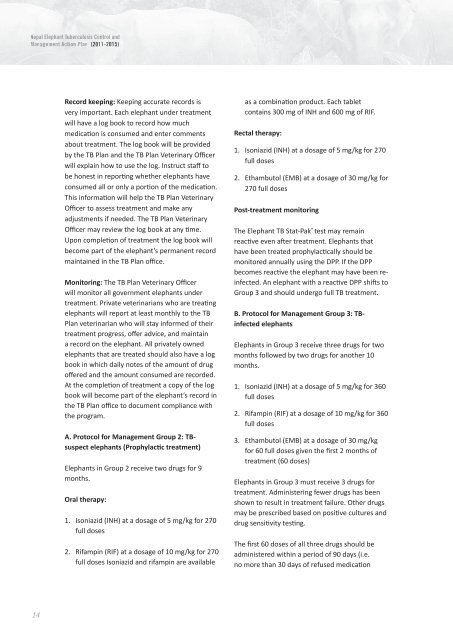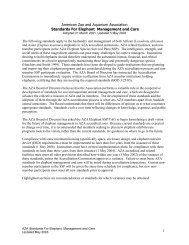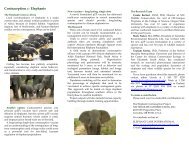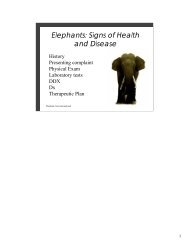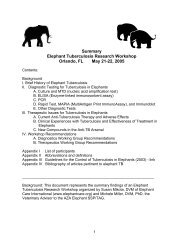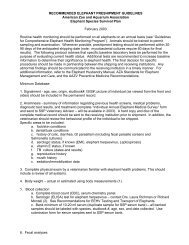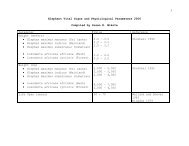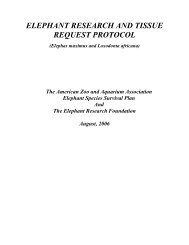Nepal Elephant TB Control and Mgt Action Plan.pdf - Elephant Care ...
Nepal Elephant TB Control and Mgt Action Plan.pdf - Elephant Care ...
Nepal Elephant TB Control and Mgt Action Plan.pdf - Elephant Care ...
- No tags were found...
Create successful ePaper yourself
Turn your PDF publications into a flip-book with our unique Google optimized e-Paper software.
<strong>Nepal</strong> <strong>Elephant</strong> Tuberculosis ulosis<strong>Control</strong> <strong>and</strong>Management agemen<strong>Action</strong> <strong>Plan</strong> (2011-2015)2015)Record keeping: Keeping accurate records isvery important. Each elephant under treatmentwill have a log book to record how muchmedicaon is consumed <strong>and</strong> enter commentsabout treatment. The log book will be providedby the <strong>TB</strong> <strong>Plan</strong> <strong>and</strong> the <strong>TB</strong> <strong>Plan</strong> Veterinary Officerwill explain how to use the log. Instruct staff tobe honest in reporng whether elephants haveconsumed all or only a poron of the medicaon.This informaon will help the <strong>TB</strong> <strong>Plan</strong> VeterinaryOfficer to assess treatment <strong>and</strong> make anyadjustments if needed. The <strong>TB</strong> <strong>Plan</strong> VeterinaryOfficer may review the log book at any me.Upon compleon of treatment the log book willbecome part of the elephant’s permanent recordmaintained in the <strong>TB</strong> <strong>Plan</strong> office.Monitoring: The <strong>TB</strong> <strong>Plan</strong> Veterinary Officerwill monitor all government elephants undertreatment. Private veterinarians who are treangelephants will report at least monthly to the <strong>TB</strong><strong>Plan</strong> veterinarian who will stay informed of theirtreatment progress, offer advice, <strong>and</strong> maintaina record on the elephant. All privately ownedelephants that are treated should also have a logbook in which daily notes of the amount of drugoffered <strong>and</strong> the amount consumed are recorded.At the compleon of treatment a copy of the logbook will become part of the elephant’s record inthe <strong>TB</strong> <strong>Plan</strong> office to document compliance withthe program.A. Protocol for Management Group 2: <strong>TB</strong>suspectelephants (Prophylac!c treatment)<strong>Elephant</strong>s in Group 2 receive two drugs for 9months.Oral therapy:1. Isoniazid (INH) at a dosage of 5 mg/kg for 270full doses2. Rifampin (RIF) at a dosage of 10 mg/kg for 270full doses Isoniazid <strong>and</strong> rifampin are availableas a combinaon product. Each tabletcontains 300 mg of INH <strong>and</strong> 600 mg of RIF.Rectal therapy:1. Isoniazid (INH) at a dosage of 5 mg/kg for 270full doses2. Ethambutol (EMB) at a dosage of 30 mg/kg for270 full dosesPost-treatment monitoringThe <strong>Elephant</strong> <strong>TB</strong> Stat-Pak ® test may remainreacve even a!er treatment. <strong>Elephant</strong>s thathave been treated prophylaccally should bemonitored annually using the DPP. If the DPPbecomes reacve the elephant may have been reinfected.An elephant with a reacve DPP shi!s toGroup 3 <strong>and</strong> should undergo full <strong>TB</strong> treatment.B. Protocol for Management Group 3: <strong>TB</strong>infectedelephants<strong>Elephant</strong>s in Group 3 receive three drugs for twomonths followed by two drugs for another 10months.1. Isoniazid (INH) at a dosage of 5 mg/kg for 360full doses2. Rifampin (RIF) at a dosage of 10 mg/kg for 360full doses3. Ethambutol (EMB) at a dosage of 30 mg/kgfor 60 full doses given the first 2 months oftreatment (60 doses)<strong>Elephant</strong>s in Group 3 must receive 3 drugs fortreatment. Administering fewer drugs has beenshown to result in treatment failure. Other drugsmay be prescribed based on posive cultures <strong>and</strong>drug sensivity tesng.The first 60 doses of all three drugs should beadministered within a period of 90 days (i.e.no more than 30 days of refused medicaon14


